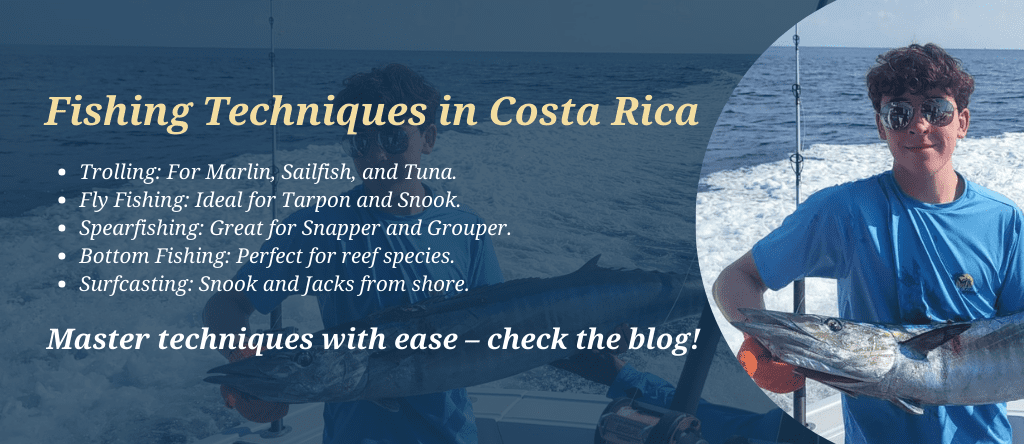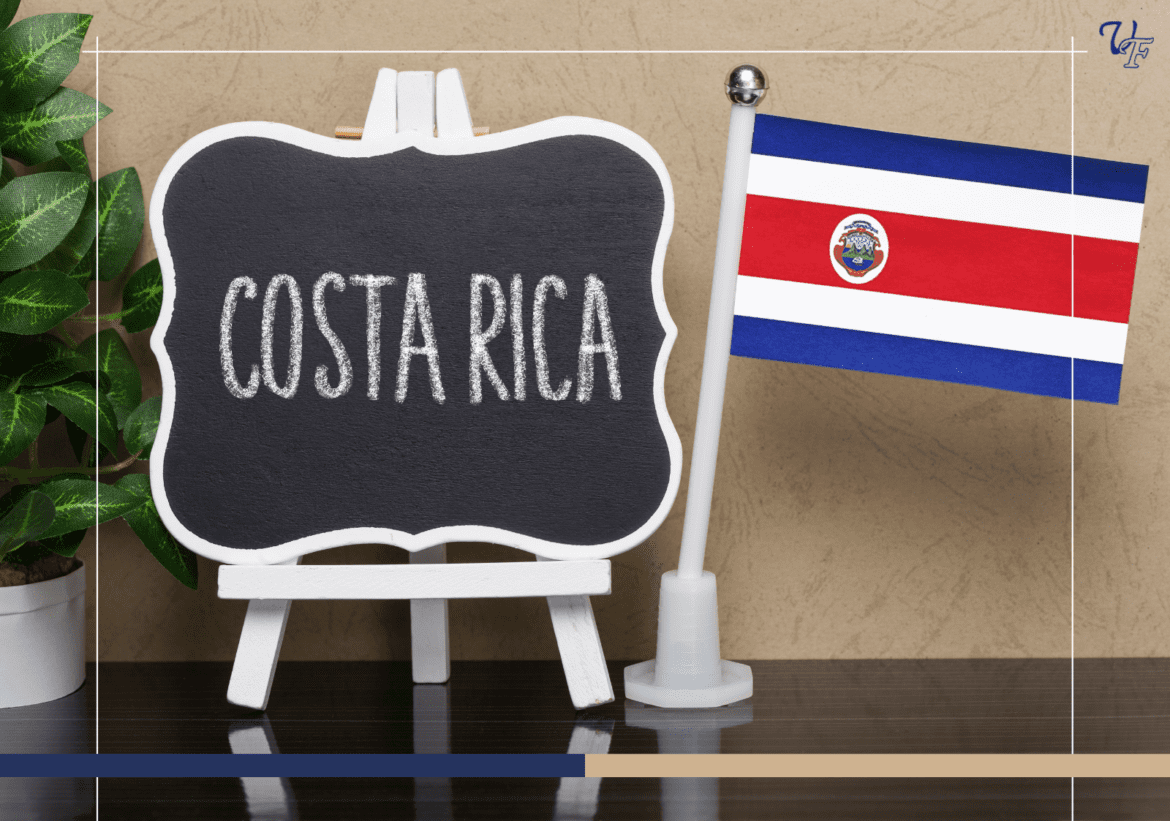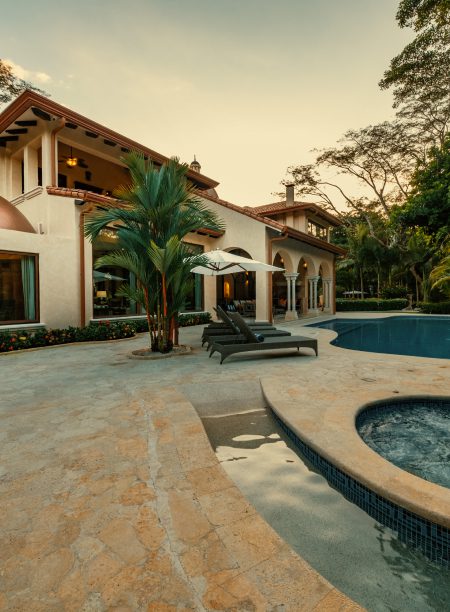The rich marine biodiversity and stunning coastlines of Costa Rica make it a global fishing hotspot that attracts every fishing enthusiast from around the world. This fishing paradise offers incredible opportunities for anglers of all levels.
Whether chasing marlin in the Pacific or tarpon in the Caribbean, the right technique can make all the difference. The country’s unique ecosystems support various fishing methods, each offering a distinct and rewarding experience.
This blog post covers the most used and preferred fishing techniques every angler should know. Let’s explore them together.
Trolling – The Key to Deep-Sea Success
What Is Trolling?
Trolling consists of pulling baited lines or lures behind a moving boat. It is meant to imitate the natural movement of a struggling fish in open water. This setup is a favorite for many offshore anglers because it is effective in attracting large-game fish, which can sometimes provide a thrilling experience and some fine catches.
Target Species
Trolling is particularly effective for catching large and powerful species like marlin, sailfish, tuna, and dorado. These game fish species are attracted to the movement and color of the bait or lure, making trolling an exciting way to reel in impressive catches.
Best Locations
The Pacific Coast of Costa Rica offers some of the best trolling locations. Los Sueños, Quepos, and Tamarindo are renowned for their abundant marine life and proximity to deep waters, providing prime opportunities for anglers to succeed.
Tips for Success
Trolling can be incredibly rewarding when executed properly. To increase your chances of success, keep these tips in mind:
- Use brightly colored lures or mackerel and squid as bait to catch the big-game fish.
- Schedule the trips during dry season, from December to April. Game fish can be more active, and their habitat is not much of a concern.
- Adjust the trolling speed based on the species to be caught. Marlin and tuna are best caught using high-speed trolling, but sailfish can sometimes come to slower-moving lures.
- Pay attention to water temperatures and focus on areas with favorable conditions for your target species.
- Equip your boat with multiple rods to cover various depths and increase your chances of success.
Jigging – Mastering the Depths
What Is Jigging?
Jigging involves using weighted lures called jigs that move vertically in the water column and imitate injured prey. The method is particularly efficient at catching bottom dwellers because it incites the predator instinct in bottom-lurking species.
Target Species
Jigging is directed at bottom dwellers such as grouper, snapper, and amberjack. These fish are often near underwater structures, and they love the fast-moving jig.
Best Spots
The deep reefs off Papagayo Gulf and Drake Bay are good locations for jigging. The locations are characterized by a high density of underwater structures that attract different bottom dwellers.
Tips for Successful Experience
Jigging is a dynamic and rewarding technique, but anglers need to prepare and be quite technical to get the most out of it. These tips will help you improve your results:
- Use metal jigs for deeper waters and lighter ones for shallower areas, adapting your choice to the depth and conditions of the fishing spot.
- Retrieve at varying speeds in an attempt to emulate the natural movements of prey and induce strikes.
- Use slow then fast retrieves and switch over time to see what best imitates the target species.
- Choose jigs that mirror the forage base of the fish to be targeted, or those silvers/goldens that best mimic baitfish for that extra attraction.
- Utilize a good-quality jigging rod and reel combination that will withstand the high-speed repetitive action and the pull for comparatively large catches.
- Pay attention to the tide and current patterns because they might influence fish activity and the effectiveness of your jigging technique.
Fly Fishing – A Unique Adventure
What Is Fly Fishing?
Fly fishing is a specialized and graceful technique employing lightweight, artificial flies that mimic the behavior of insects or small baitfish behavior. This approach demands precision, patience, and skill but rewards anglers with an immersive and unforgettable fishing experience.
Target Species
Fly fishing in Costa Rica provides the best environment for catching tarpon and snook. These species are known to produce acrobatics and strength due to their features that attract anglers who desire a challenge.
Best Places
The Caribbean estuaries that comprise Tortuguero and Barra del Colorado are renowned for fly fishing. The smooth condition of waters, and thriving fish population create optimum conditions for success.
Tips for Success
Fly fishing is as much an art as it is a skill. Preparation and attention to detail are key to making the most of this rewarding technique. Consider the following tips:
- Equip yourself with an 8-10 weight rod and saltwater-resistant reels, as these are essential for handling the strength of tarpon and snook.
- Practice casting techniques, especially double-haul casting, to manage windy conditions and ensure accurate fly placement.
- Use flies that mimic local baitfish or insects, such as streamers or poppers, to increase the chances of them attracting the species in view.
- Seek areas of heightened activity of tarpon leaping and swirling waters that could give a cast indication of better casting places.
- Put on polarized sunglasses, as these will remove most glare, improving the possibility of spotting your prey.
Spearfishing – The Last Full Contact Discipline
What Is Spearfishing?
Spearfishing is one of the oldest and most exciting water techniques. Anglers catch fish using spears or spearguns. With immense endurance and razor-sharp focus, no fishing technique immerses the angler in the sea as much as spearfishing does.
For anyone who thinks about adventure under the waves, spearfishing provides a thronging activity that deeply rewards.
Target Species
The fish commonly targeted with the spear are snapper, grouper, and roosterfish. These often stay in coral reefs and areas of rocky shoreline, so there is a relatively good chance a diver will get a shot.
Excellent Spots
Reefs along Manuel Antonio and Playa Flamingo provide good spearfishing. Visibility is good here, and this area is highly populated with marine life, so chances are good the angler won’t be disappointed.
What to Do?
This thrilling sport of spearfishing involves skill, responsibility, and safety together; it’s what it requires in practice. Keep in mind to consider the following for a proper successful experience during or after the activities:
- Always go with a buddy, and consider all the applicable safety rules prevailing in the country.
- Apply sustainable fishing techniques, such as not killing more than the allowed amount and limiting fishing to specific species at the site to prevent harm.
- Invest in good-quality fishing equipment, such as a well-fitted wetsuit, durable speargun, and sharp spear tips to increase the accuracy and comfort of dives.
- Research the habits and habitats of target species to increase your chances of catching and conserving energy underwater.
- Maintain proper buoyancy control to minimize disturbance to the underwater environment and make spearfishing more efficient.
Bait Fishing – The Classic Approach
What Is Bait Fishing?
Bait fishing is a proven technique that employs live or artificial bait to attract fish. This technique helps anglers catch a wide variety of species in different environments, making it one of the most adaptable and effective fishing techniques.
Target Species
This technique is suitable for catching roosterfish, snapper, and sailfish. These species are attracted to the natural movement of live bait or the appearance of artificial alternatives.
Best Spots
Tamarindo and areas inshore to offshore waters are best for bait fishing. These regions host a lot of marine life, which makes them quite popular with anglers.
Tips for a Successful Experience
Bait fishing can be quite fruitful if the method is applied effectively.
- Anglers can get the most out of fishing by concentrating on the right baits and techniques.
- Live bait like sardines or mullet works well for inshore species, offering a natural and enticing option for attracting fish.
- Use drifting techniques in deeper waters to target larger fish. This allows the bait to move naturally with the current and mimic prey.
- When live bait is unavailable or impractical, choose artificial bait, such as soft plastics or crankbaits, for specific species.
- Keep your bait fresh and store it properly to ensure its effectiveness and appeal to fish.
- Change the depth of your fishing several times to discover where the fish are most active, especially during changing water temperatures or conditions.
Bottom Fishing – Great for Reefs and Depths
What Is Bottom Fishing?
Bottom fishing involves the strategic placement of baited rigs on the seafloor to target fish that dwell in these depths. This approach is perfect for anglers aiming to catch species that thrive near underwater structures, such as reefs and rocky outcrops. It offers an exciting and rewarding challenge for those who enjoy exploring the ocean’s hidden corners.
Target Species
Grouper and snapper are species usually caught by bottom fishing. As the name suggests, bottom-dwelling fish feed on the bottom or hide in various structures such as rocks or reefs.
Best Spots
The Gulf of Papagayo and the Gulf of Nicoya are the best places for bottom fishing. Their diverse underwater features make them suitable for catching bottom-dwelling species.
Tips for Success
Bottom fishing is a rewarding technique, especially when you know how to maximize its potential. Here are some tips that can increase your chances of reeling in a great catch:
- Use strong rigs with circle hooks for a secure catch. These hooks are designed to latch onto the fish without causing excessive harm, making them ideal for responsible fishing.
- Target areas containing underwater structures like rocks or reefs. Most bottom feeders hide around these sites in search of food or shelter.
- Use heavier-duty lines and rods because big fish tend to exist at the bottom.
- Consider tides as they have their movement and periods, so consider targeting when they are slack for greater fish action by bottom-dwelling fish.
- Use fresh bait such as squid or cut fish to attract species such as grouper and snapper. Fresh bait increases the aroma and attractiveness, therefore improving your prospects.
Surfcasting and Shore Fishing
What is Surfcasting and Shore Fishing?
Casting baits or lures from beaches or rocky shorelines combines simplicity with the thrill of reeling in various fish species. This accessible technique invites anglers of all skill levels to experience the excitement of coastal fishing while enjoying stunning seaside views.
Target Species
Surfcasting and shore fishing are ideal for catching snook, jacks, and roosterfish. These species often patrol the shallow waters, making them available to shore anglers.
Best Locations
Playa Hermosa and Playa Tamarindo provide excellent spots for surfcasting. The sandy beaches and rocky outcrops of the beaches offer diversified habitats, attracting various fish species.
Helpful Tips
Surfcasting and shore fishing are simple and convenient, but fine-tuning your tactics can significantly improve your chances. Here are a few things to remember:
- To increase your chance of catching fish, catch at high tide or in the morning or evening when fish are most active.
- Use poppers and spoons as a good lure, especially to target snook and roosterfish.
- Use a longer surfcasting rod to increase casting distance and reach deeper waters from the shore.
- Wear polarized sunglasses to reduce glare and spot fish behavior and movements in the shallows.
- Observe local anglers and adapt to techniques that work well in the area, ensuring a more effective approach.
Kayak Fishing – Adventure Meets Technique
What Is Kayak Fishing?
Kayak fishing provides an angler with the opportunity to undertake a different type of adventure. Since it is accessible to shallow or remote waters inaccessible to larger boats, it allows anglers to be close to nature and explore many hidden fishing grounds full of life. It has the excitement of self-navigating while satisfying reaching untouchable places, hence preferred by those looking for solitude as well as thrills.
Target Species
Kayak fishing is ideal for targeting roosterfish, jacks, and snook. These species prefer shallower waters near the mangroves.
Top Spots
The mangroves along the Gulf of Nicoya are perfect for kayak fishing. The calm water and lush vegetation provide a prime fishing haven.
Tricks and Tips for Success
Kayak fishing provides an exciting and intimate experience with nature. Anglers can reach remote and shallow areas inaccessible by other means. However, it does require preparation and awareness to be safe and successful.
- Select a stable kayak with rod holders and enough storage space to manage your gear.
- Keep an eye on the weather and currents, which can change in minutes and may impact your fishing safety and ability.
- Wear a life jacket and bring essential safety equipment like a whistle, flashlight, and first aid kit.
- Use a fish finder or a GPS to determine the prime locations to catch more fish, including finding new spots when moving through unfamiliar waterways.
- Test launch and paddle in calm water to gain the comfort and balance necessary for traveling into rougher environments.
Local Fishing Technique

What Is Local Technique?
Traditional fishing methods practiced in Costa Rica include handlines, cast nets, and fish traps. Such practices are common in most of the coastal communities.
Local Fishing Methods
Discovering traditional fishing methods is similar to entering a tapestry rich in Costa Rican culture. Generations have shared these techniques, which represent a harmonious balance of technique and sustainability for anglers and provide a connection to the land and sea.
- Handlines: A simple hand-operated line that works beautifully for small inshore fishes. Anglers love the availability and the closeness it brings to the challenge of each catch.
- Cast Nets are a favorite tool for taking baits. They require a delicate touch and years of practice. If expertly thrown, cast nets are a perfect example of the beauty of traditional fishing skills in shallow waters.
- Fish Traps: Fish traps are a clever and sustainable way of catching many species. Usually made from natural materials, they show the ingenuity and ecological awareness of local communities.
Where to Learn?
Coastal villages and mangrove areas are valuable learning centers for traditional fishing practices. In these tranquil surroundings, local fishermen will share with visitors knowledge passed down for generations of century-old techniques that benefit not only hands-on skills but even a cultural heritage defining Costa Rica’s fishing traditions. An experience with the communities is a genuine way to connect anglers to the heart of sustainable fishing practices.
Why It Matters?
Traditional fishing techniques go beyond efficiency; they symbolize the nation’s strong sustainability commitment and cultural identity. Through the use of handlines, cast nets, and fish traps, local communities find a delicate balance between meeting modern demands while preserving the ecological balance, ensuring that these traditions last for generations to come.
Conclusion
Fishing in Costa Rica has an abundance of varieties for all the anglers out there. It ranges from marlin trolling to spearfishing along the coral reefs. This guarantees something for everybody.
Plan your fishing adventure today and discover why Costa Rica is a dream destination for anglers worldwide.











